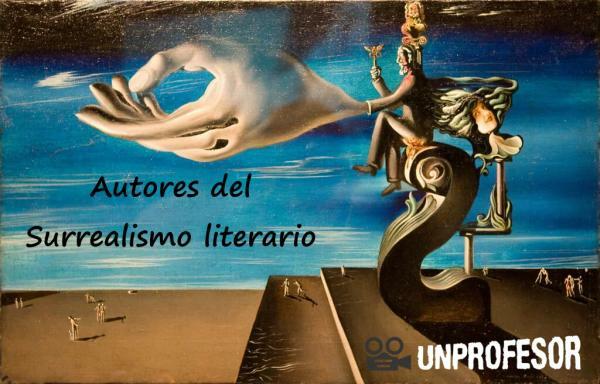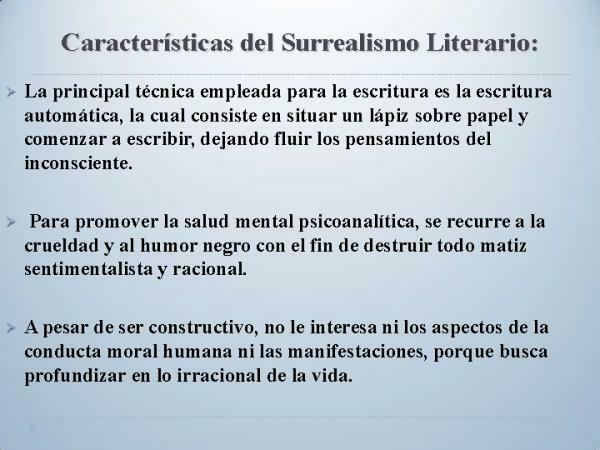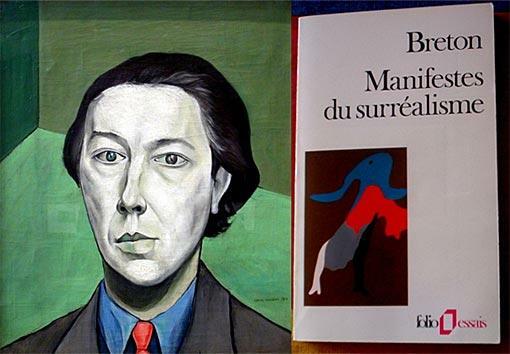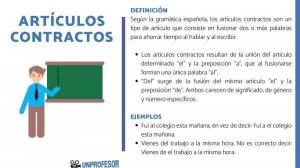The main AUTHORS of literary SURREALISM: from Europe and Spain

Early twentieth the emergence of new artistic currents took place in Europe that aimed to break with the preceding tradition to seek new, more original, groundbreaking and modern forms. Surrealism was one of them, a movement that is included within the current known as Avant-garde and that is characterized by breaking with all the norm stipulated by reason and logic to create an unconscious and natural art. In this lesson from a TEACHER we are going to talk to you about authors of literary surrealism since it was a current that, at first, focused on literary writing and, later, encompassed many other disciplines such as painting or sculpture.
Index
- Introduction to Literary Surrealism
- André Bretón, one of the authors of literary Surrealism
- Louis Aragón, another poet of literary Surrealism
- Philippe Soupault
- Literary surrealism in Spain
Introduction to Literary Surrealism.
There are many characteristics of surrealism since it was one of the most consolidated movements and with the largest number of followers in all of Europe. However, the main characteristic is that it is a type of art that
seek the breakdown of reason to, thus, enter the human unconscious and discover what is inside the mind.Influenced by Freud's psychonanalysis, the authors of literary surrealism wanted to write leaving reason aside, to write following the impulse of their impulses and of their most unconscious part. And how was that achieved? One of the techniques most used by these artists was known as "automatic writing", that is to say, a writing method that was carried out without prior programming and leaving the mind free.
André Breton was the greatest exponent of Surrealism, a French artist who in 1924 published the first surrealist manifesto in which the entire theory of this current and the methods that had to be followed in order to create works of art totally remote from the reality. Automatic writing was the method used by the authors of literary Surrealism and, by means of this technique, corrections were omitted and the mind was left completely free to create.
The objective of Surrealism was not so much as to create art but, above all, access the human unconscious and, for this, artistic methods were used since in this way the most hidden area of our mind could be better accessed. For this reason, surrealist works are full of strange shapes, mixtures of dreams and reality, images without a defined meaning, and so on.
The poetry of Surrealism
One of the favorite genres of Surrealism among the authors of this current of the literary vanguards it was poetry. Through poetic writing one could juxtapose a large number of images that were not related to each other and create very striking metaphors and mental images. The correlation of these images activated the unconscious processes making, thus, that the reader could also access the less rational side of him.
With surreal poetry they created images loaded with fantasy and unreality that called into question the logical processes of our world. Abstract ideas, surprising associations of different ideas and jumps in linearity that enhanced the most uncontrolled creativity of the mind.

Image: Monografias.com
André Bretón, one of the authors of literary Surrealism.
One of the most prominent authors of literary Surrealism (not to say the most) was André Breton who is considered to be "the father" of the surrealist movement. This Frenchman aligned himself with the avant-garde movement creating a very groundbreaking new trend that caused a great impact among the creators of the moment.
Breton's influence for the creation of Surrealism was theDada movement, another current that is also part of the avant-garde "isms". Inspired by the break with the tradition defended by the Dadaists and, also, by the study of the Freud's psychonalysis, Breton published the First Surrealist Manifesto which consisted of the theoretical grouping of this movement.

Image: Artemuros
Louis Aragón, another poet of literary Surrealism.
In addition to André Breton, in the literary Surrealism movement there are also other proper names that were very prominent. This is the case of the also French Louis Aragon, Parisian and great friend of Breton with which he edited the magazine "Literatura" in 1919, a publication that was part of Dadaism.
As with Breton, Aragon also focused on Surrealism to create his literary works. It was the main defender of automatic writing as an ideal method to access the creative unconscious. Thanks to this technique, the author managed to transfer the most natural thoughts from the mind to paper, far from the control of logic and reason.
Ideologically, Aragon began to align with communism and, therefore, in "Le Monde Reel" we can see a large number of surrealist texts in which he attacks bourgeois norms and defends Marxist ideas. In addition to literature, this author also contributed other works such as history, art, culture, etc., resulting in a published corpus of more than a hundred books.

Image: Slideshare
Philippe Soupault.
Another of the great names of authors of literary surrealism in France was Phillippe Soupault, a writer who also began his literary career in the Dada movement at the hands of Tristan tzara but that, later, he aligned himself with Breton and Aragon to found Surrealism as another current of the artistic avant-gardes.
One of Soupault's main contributions is "Magnetic fields", the first work written using the automatic writing technique. In the 1927 Soupault he disassociated himself from Breton's Surrealism because it was ideologically aligned with the Communist Party.
Literary surrealism in Spain.
And to conclude this lesson on the authors of literary Surrealism, we are now going to talk about the Spanish authors who followed the foundations of this avant-garde current. This movement was of great interest in the Spanish culture of the 1930s but, before this time, we find a precursor Spanish surrealist: Ramon Gómez de la Serna.
But the authors of Spanish literary surrealism who most followed the premises of this current were poets of the generation of 27like, for example, the ones we mention here:
- Vicente Aleixandre: he is the Spanish surrealist author par excellence. In fact, he himself described himself as a super-realistic poet although, yes, he indicated that his method was not that of automatic writing.
- José María Hinojosa: published "La flor de California", a collection of poems in which the dreamlike essence so defended by the surrealists abounds
- Rafael Alberti: This well-known Spanish poet also felt the influence of Surrealism, something that can especially be seen in "Sobre los angeles" or "Sermones y moradas"
- Miguel Hernandez: This Spanish author also had a brief period in which Surrealism influenced his style.
Literary Surrealism in Latin America
In Latin America, Surrealism also had some authors who followed the movement defended and theorized by Breton. Some of the authors who were influenced by the surrealist current They were:
- Braulio Arenas
- Cesar Moro
- Octavio Paz
- Xavier April
- Alejo Carpentier
- Cesar Vallejo
- Jorge Luis Borges
- Julio Cortazar

Image: Google Sites
If you want to read more articles similar to Authors of Literary Surrealism, we recommend that you enter our category of History of Literature.
Bibliography
- Nadeau, M., & Riviere, M. P. (1972). History of surrealism (p. 137). Barcelona: Ariel.
- Durozoi, G., & Lecherbonnier, B. (1976). André Breton: surrealist writing. Guadarrama.
- Pont, J. (Ed.). (2001). Surrealism and literature in Spain. University of Lleida.


